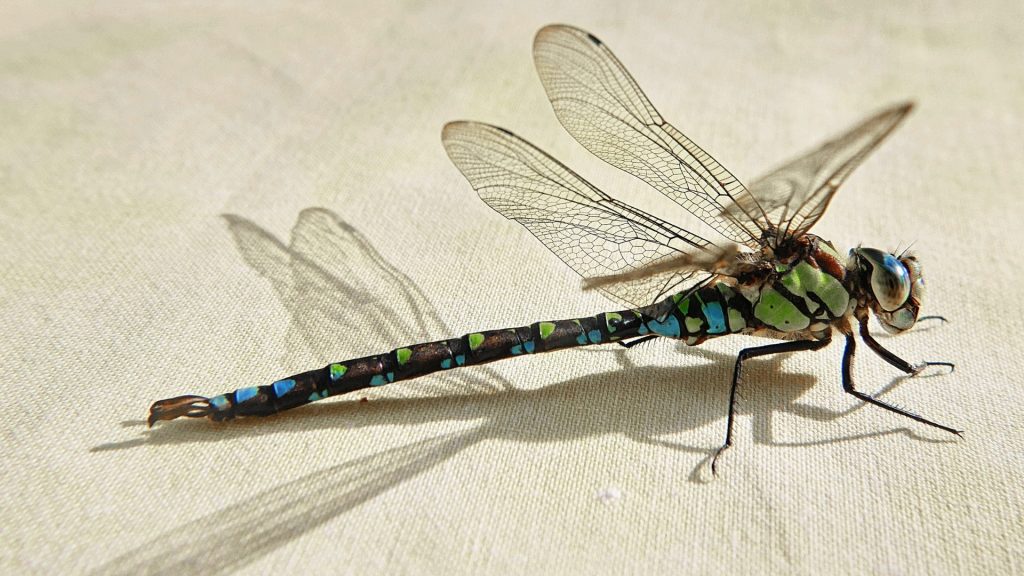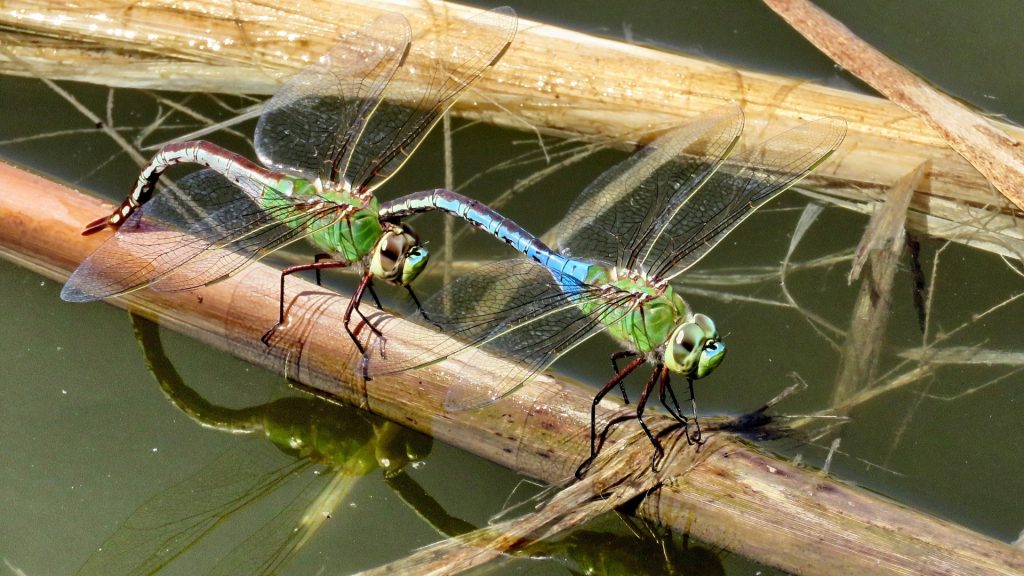Dragonflies are one of the oldest insects that ever roamed the earth. They have large, strong jaws and basket-like gantry legs used to catch their prey.
Do dragonflies bite or sting? Dragonflies do bite, not sting. These insects don’t have a stinger, so they can’t sting. They bite only to protect themselves, but there’s nothing to worry about as their bite isn’t dangerous. So, if you try to catch them, there’s a high possibility they’ll bite.
According to National Geographic, there are around 7,000 species of dragonflies today with their closely related damselflies, forming the group Odonata. This means ‘toothed ones,’ which are considered to be ancient.

By reading on, you can learn more about dragonflies and how you can identify them apart from other flying insects.
How to Identify a Dragonfly?

| Common Name | Other Names | Scientific Name | Average Size | Prey |
| Dragonfly | Skimmer Mosquito hawk | Suborder Anisoptera | 3/4 to 2 inches (depending on the species) | Mosquitoes Gnats Flies Ants Termites |
Identifying a dragonfly isn’t challenging when landed at a close range. However, this gets tricky once the dragonfly starts flying rashly.
Nonetheless, most of these insects land sometimes. So, you can try to get a good look and identify them when that happens. It will also be helpful to know the basic anatomy of a dragonfly in identifying them. They have a head, thorax, and abdomen.
Furthermore, you may observe the following features as you try to see them closely:
- Wings are attached on the top of their thorax.
- Legs are found on the bottom.
- Their thorax is tilted backward.
- Their thorax has three segments, having a pair of legs on each part.
- The neckline section of dragonflies is separated from the other two parts. These sections are connected to the thorax—bearing the middle and hind legs, along with the two sets of wings.
- Most of their body is taken by the big flight muscles.
The shape of their abdomen helps in identifying the sexes of these dragonflies.
- Males have a distinct bulge under their secondary genitalia.
- Females don’t have protruding structures and generally have a broader and enlarged abdomen to carry many eggs.
Types of Dragonfly
There are two types of dragonflies when it comes to foraging style—the fliers and the perchers.
Fliers: They fly around to catch their prey while perchers rest on seats, observing their target, the predators, and their species members.
Perchers: They are more aware of their environment, while fliers tend not to care about their surroundings. Fliers don’t look around compared to perches that are often turning their heads, sensing their environment.
What Is Special About a Dragonfly?
Apart from the fact that these insects come from an ancient descent, they’re also one of the fastest flying insects in the world. They can fly over 30 miles per hour and consist of beautiful, diverse hues on the planet.
Dragonflies are among the most colorful insects today that are highly beneficial to the environment and people. They typically feed on mosquitoes, which are carriers of the worst diseases, such as dengue and malaria.
Do Dragonflies Like Humans?
Dragonflies are essentially harmless to humans, except when provoked. This being said, dragonflies might actually like humans.
These insects also reduce the presence of other harmful insects, such as the following:
- Mosquitoes
- Flies
- Midges
- Moths and other flying insects
The ferocious preying of dragonflies to mosquitoes and other harmful insects reduces the dangers of fatal insect bites to humans. Thus, it’s always good to have these insects around.
They decrease the sources of dangerous and infectious diseases, making your living environment safer from the dangers of malaria and dengue.
Do Dragonflies Bite or Sting?
As mentioned above, these insects don’t have a stinger, so they can’t sting. However, they have some teeth, so they’re capable of biting.
Nevertheless, there’s nothing to worry about as their bites aren’t fatal. They will only attack if you provoke them, as a part of protecting themselves.
What Does a Dragonfly Bite Look Like?
The bite of the dragonfly looks like a small red dot. As you might already know, these insects have two sharp mandibles that can slightly go into your skin, causing the red dot.
Their bites can’t break your skin since they’re not that strong. They’ll only leave a little red dot mark on you if you irritate them.
Are Dragonfly Bites Poisonous?
The bites of dragonflies aren’t poisonous. They can’t kill you. Its cud isn’t poisonous, so they’re practically harmless insects.
Thus, if you’ve got bitten, there’s no need to get hysterical. These insects will only attack you if you try to seize them, making them feel threatened.
Additionally, dragonfly larvae don’t harm people, despite their fierce appearance. However, the larger species of late-instar larvae may use their sharp mandibles to nip someone intrusive to them.
Do Dragonflies Bite Pets?

Dragonflies will never bite your pets unless they feel threatened. Their bites aren’t also venomous, so your pets are practically safe.
Dragonflies don’t bite cats, dogs, or any other pets. They’re peace-loving insects and will only dare to nip if they feel they’re in danger.
What Happens if You Touch a Dragonfly?
If you touch a dragonfly, there’s a possibility that you’ll get bitten. Although its bite isn’t fatal, it’ll leave a red dot mark on your skin.
What Attracts Dragonflies to My Yard?

Water
Dragonflies are attracted to water. They love to spend most of their time around water and lay their eggs there and perch on available vegetation.
Some of them also prefer flowing water, while others want standing water. If you have a bubbler or a fountain in your vicinity, don’t get surprised if you’ll see them flying in your yard.
Vegetation
Another thing that attracts dragonflies to your yard is vegetation. Dragonflies also need vegetation for their survival.
Thus, if you’ve got some vegetation, they’ll practically live around your yard, especially if you have partially submerged vegetation. They love these types of vegetation as they give protection to their eggs.
Floating plants also attract dragonflies to your place. These types of plants provide adult perches either for resting or laying eggs.
Pollinator Plants
If you have pollinator plants in your place, dragonflies will naturally come and go to your yard. Some pollinator plants include but are not limited to:
- Dahlia
- Daisy
- Dandelion
- Coneflower
- Butterfly plants
- Lavender
If you’ve got a pond, having buttercups, lilies, and irises, you can attract more dragonflies to your place. This will make your home dreadful to mosquitoes, flies, and other harmful flying insects.
Thus, having these insects in your yard is highly beneficial as they feed on mosquitoes. So, if mosquitoes pester you, attracting them to your place could be your solution to end your mosquito problems.
Are Dragonflies Good for a Pond?

Dragonflies are unquestionably good for ponds and other water gardens. They help manage flies, mosquitoes, and other harmful flying insects, such as midges and moths.
Thus, having dragonflies for a pond is an excellent way of naturally driving away dangerous and annoying insects. With these insects around, it means that your pond has a healthy ecosystem.
Why Do Dragonflies Skim the Water?
Dragonflies skim the water to adjust their body temperature. They usually do this when the temperature is high.
Skimming the water also prevents them from losing moisture due to the high environmental temperature.
Do Dragonflies Carry Diseases?
Dragonflies don’t carry diseases to humans. They ward off various diseases like malaria and dengue by reducing their sources—the mosquitoes.
Mosquitoes are one of the primary diets of dragonflies, making your environment mosquito-less.
Related: How To Kill Mosquito Larvae? | Information & Tips
Summary
Dragonflies are essential to the environment, as they primarily feed on harmful insects. This means dragonflies can reduce the risk of diseases associated with insects like mosquitoes.
Thus, if you’ve been pestered by various pests like flies, mosquitoes, moths, and many others, it’s time to attract dragonflies to your place.
You can do that by having vegetation, water (flowing or standing), and pollinator plants in your yard. This way, your environment can get their attention, drawing them to your place and eliminating the annoying flying insects within your vicinity.
List of Sources
Peyman-Sabet, J. (2000). Dragonflies and Damselflies. University of California, Berkeley.
Baker, L. Dragonflies. Texas A&M AgriLife Extension Service.
Fike, M. (1997). What about dragonflies. Pacific Northwest National Laboratory.
- How to Get Rid of Copperheads | Practical Guide - August 27, 2023
- How to Get Rid of Corn Snakes | What Makes Them Aggressive? - August 27, 2023
- How to Get Rid of Alligators | Safety Measures and Removal Methods - July 16, 2023
